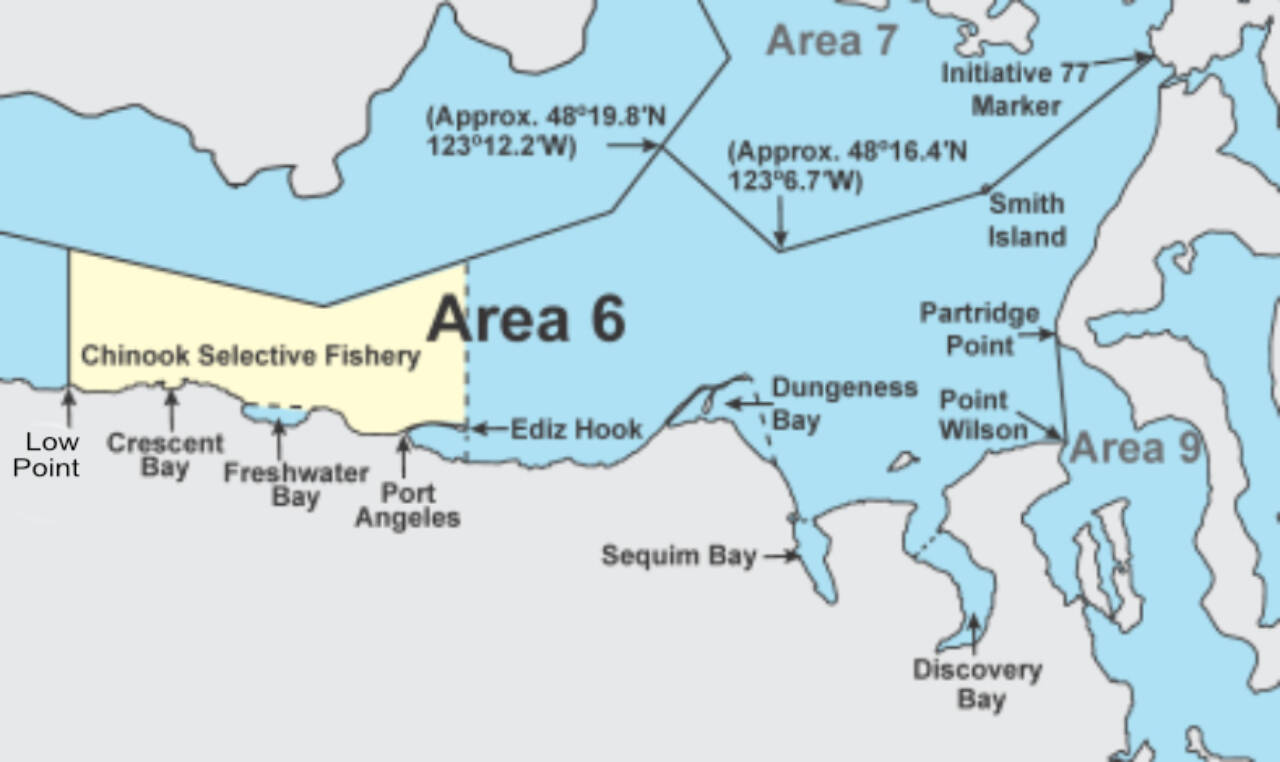OLYMPIA — Salmon fishing at Sekiu — Marine Area 5 — will return to seven days a week after Washington Department of Fish and Wildlife fishery managers determined enough Chinook remained in the recreational catch quota following initially high catch rates.
Because catch rates have decreased since the opener, WDFW decided to relax restrictions, allowing for more days to be open. Estimates for the Sekiu summer Chinook fishery through July 17 indicate the fishery has reached 40 percent of the legal-size encounters — 2,967 of 7,342 fish.
“What happened in Sekiu this year is a great example of how WDFW staff work closely with constituents to manage fisheries and ensure seasons last,” said Kirsten Simonsen, Ph.D., WDFW’s Puget Sound recreational salmon manager. “While additional restrictions are never easy, we worked closely with members of the Sekiu fishing community to craft a fishery that worked for them.”
Sekiu will be open daily through Aug. 15 for salmon fishing. Daily limit is two fish, with up to one hatchery Chinook allowed. Chinook minimum size is 22 inches. For other salmon species there is no minimum size. All wild Chinook, wild coho and chum must be released. The Sekiu salmon fishery is scheduled to switch to Chinook non-retention on Aug. 16. The season may close earlier if Chinook guidelines are attained.
Area 6 Chinook Selective Fishery Area
The Marine Area 6 Chinook Selective Fishery Area is open Wednesdays through Saturdays only beginning July 27 through Aug. 15 from Low Point east to a true north/south line through the No. 2 Buoy immediately east of Ediz Hook, excluding the Port Angeles Harbor and Freshwater Bay areas.
A reduction in days was recommended by Puget Sound Recreational Fishery Advisors and representatives of the Marine Area 6 community to extend the Chinook season as long as possible.
Estimates for the Marine Area 6 Chinook Selective Fishery Area through July 17 indicate the fishery has reached 65 percent of the legal-size encounters (6,155 of 9,400 fish) and catch rates have been high to date.
On open days, the Marine Area 6 Chinook Selective Fishery Area daily limit is two, with up to one hatchery Chinook. Chinook minimum size is 22 inches. For other salmon species, there is no minimum size. All wild Chinook, wild coho and chum must be released.
WDFW announces more halibut days
OLYMPIA — Halibut anglers will have several extra days to reel in halibut this season as well as two opportunities to help shape the 2023 season, fishery managers with the Washington Department of Fish and Wildlife announced Thursday.
“Weather this spring was consistently poor so there’s enough sport allocation to support this additional opportunity for anglers in all marine areas,” said Lorna Wargo, WDFW intergovernmental fisheries policy coordinator.
The halibut season for the Neah Bay and La Push — Marine Areas 3 and 4 — will open on Thursday, Aug. 11, five days per week, Thursday through Monday. Starting Sept. 6, Neah Bay and La Push will open seven days per week.
Puget Sound — Marine Area 5 (Sekiu River to Low Point), Marine Area 6 (Low Point to Point Wilson) and through to Marine Areas 7, 8, 9 and 10 — will reopen on Thursday, Aug. 11, for seven days per week. Halibut is quota-managed and the season runs through Sept. 30 or when the quota is reached.
Halibut meetings
WDFW will host two virtual public meetings, slated for 5:30 p.m. to 7:30 p.m., on Tuesday, Aug. 9 and Tuesday, Oct. 4 to discuss season structure and proposed dates for the 2023 sport halibut season. These meetings will help WDFW fishery managers gather stakeholder input prior to Pacific Fishery Management Council meetings in September and November, when the Council will consider changes to season structure.
“As we wrap up this year’s season, these meetings are a good opportunity to hear from the public on how this year’s fishery went and how we might adjust in the upcoming year,” Wargo said.
At the Aug. 9 meeting, state halibut managers will review preliminary 2022 season data and work with stakeholders to develop a range of preliminary options focused on general concepts, such as ways to extend the season length and maximize fishing opportunity.
At the Oct. 4 meeting, in addition to refining the options developed at the first meeting, WDFW staff will collect further public input, review tide calendars for next spring and select specific season dates that attempt to balance needs across various fishing communities and charter and private fishing interests.
For more information about how to participate in the Aug. 9 and Oct. 4 Zoom webinars, visit wdfw.wa.gov/fishing/regulations/halibut. The meetings will be recorded and posted online so people can also watch the meetings afterward. Because halibut fisheries are managed to a quota, closures can happen quickly. Anglers should check the WDFW website or Fish Washington app to ensure a specific area is open prior to fishing.

